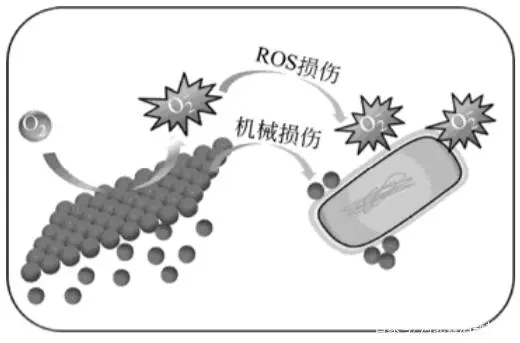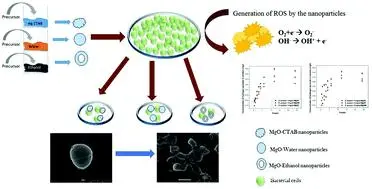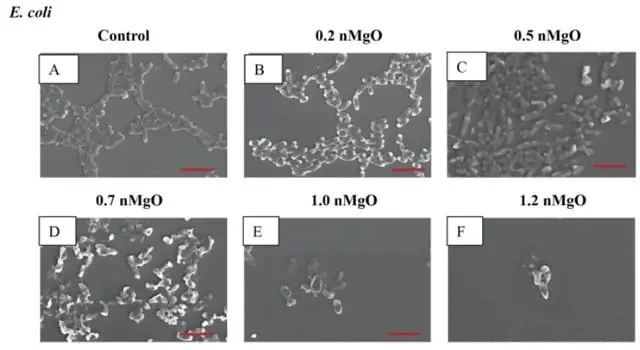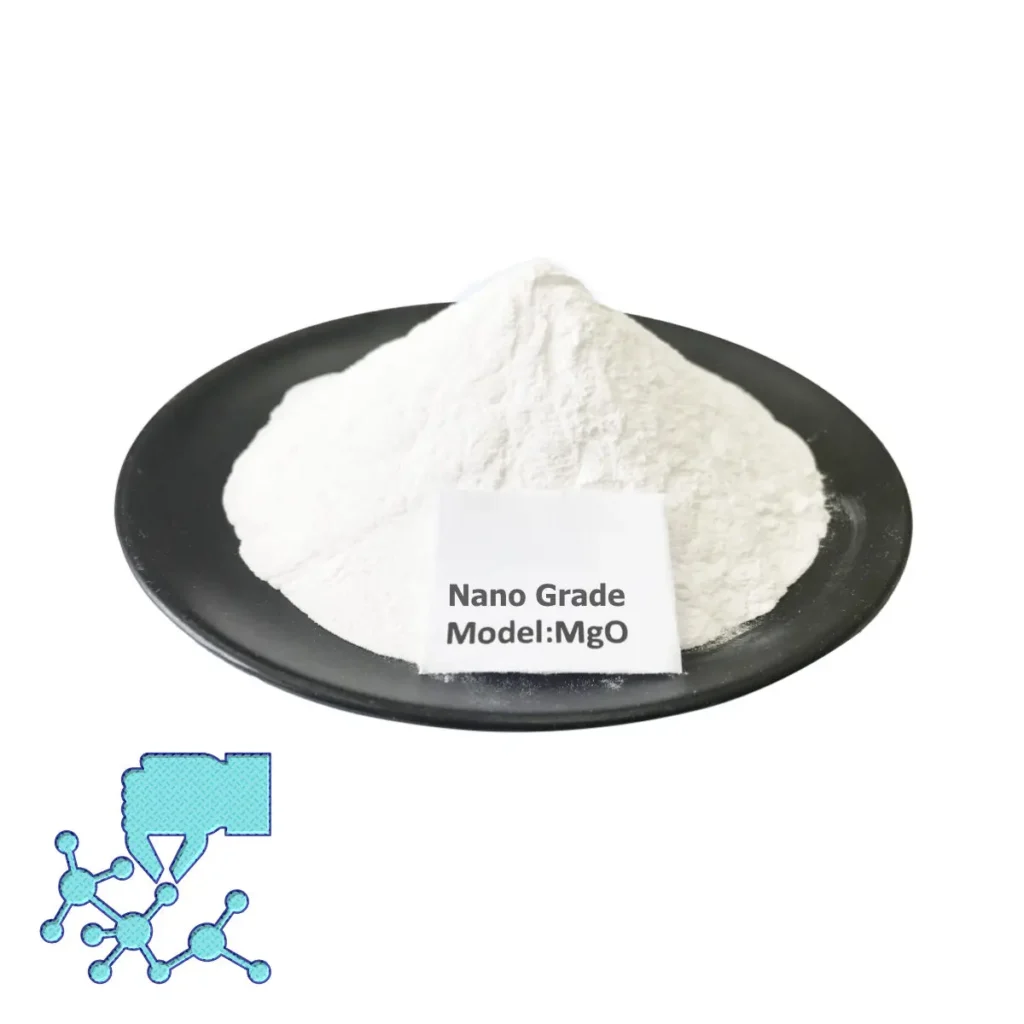Nano-magnesium oxide (nano-MgO) has become a new type of functional inorganic material due to its many optical, electrical, magnetic, thermal, chemical and mechanical properties that are different from bulk magnesium oxide. Especially in the field of antibacterial materials that are closely related to human survival and health, it has shown unique advantages, such as long-lasting and broad-spectrum antibacterial activity, low cost, not easy to change color, and no biological toxicity.
1. How does nano-magnesium oxide fight bacteria?
Correctly understanding the antibacterial mechanism of magnesium oxide is of great significance for improving the research on the antibacterial activity of materials. The figure below shows the two main antibacterial mechanisms of magnesium oxide, including oxidative damage by reactive oxygen species and mechanical damage by adsorption.

① Reactive oxygen species (ROS) oxidative damage
Messi Biology proposed the reactive oxygen species (ROS) oxidative damage mechanism of MgO when studying ceramic powders, that is, the oxygen vacancies on the surface of nano-MgO can catalyze the single-electron reduction reaction of dissolved oxygen in water to produce superoxide anion radicals O2–. Since O2– has strong oxidizing properties, it can destroy the protein peptide chains of bacterial cell membrane walls, thereby quickly killing bacteria.

MgO is easily hydrated in aqueous solution to generate Mg(OH)2, which makes the particle surface coated with a layer of OH– and alkaline. In an alkaline environment, O2– has high chemical stability and bactericidal ability. Compared with bulk MgO, nano-MgO has a large specific surface area and many surface oxygen defects. It is easy to hydrate to generate Mg(OH)2 and can produce a large amount of O2–, thus having strong bactericidal ability. Studies have shown that Mg(OH)2 generated by MgO hydration will increase the pH of the solution to about 10.5, while the bactericidal effect of NaOH aqueous solution with the same pH on Escherichia coli (E.coli) and Staphylococcus aureus (S.aureus) is not as good as that of nano-MgO, indicating that a simple increase in pH cannot promote the improvement of antibacterial properties.
The ROS oxidative damage mechanism has been recognized by most researchers. When preparing nano-MgO antibacterial materials, its antibacterial ability can be enhanced by exposing the (111) crystal plane rich in active oxygen on the surface, or by increasing the defects on the surface of magnesium oxide by doping to produce more oxygen vacancies, or by compounding with different antibacterial components to improve the antibacterial properties of the material.
② Mechanical damage caused by adsorption
There are a large number of active sites such as crystal-pattern confined hydroxyl groups, free hydroxyl groups and ion holes on the surface of nano-MgO, which can serve as adsorption and surface reaction centers. YAMAMOTO et al. proposed that in addition to ROS oxidative damage, the adsorption of particles on microorganisms can also cause cell membrane damage, and the antibacterial effect is better as the particle size decreases.
Messi Biology also found that in the absence of ROS, nano-MgO still has strong antibacterial properties against E. coli. Bacterial death should be due to changes in cell membrane pH and Mg2+ release during contact with nano-MgO, leading to cell membrane rupture, rather than lipid peroxidation. Hebei Xintao New Materials Technology Co., Ltd. used nano-MgO to act on bacteria, and the electron-dense black spots showed that it could penetrate the cell membrane or cell wall to enter the cell. The smaller the MgO particle size, the more electron-dense black spots in the cytoplasm, and the higher the antibacterial activity; the study also found that amorphous nano-MgO has no bactericidal ability.

The shape of Escherichia coli was obviously distorted, and its cell wall and cell membrane were damaged
The mechanical damage mechanism of adsorption is a supplement to the oxidative damage mechanism of reactive oxygen. It can not only explain the problem that magnesium oxide still has good antibacterial properties in the absence of ROS, but also verify the mechanism that the smaller the nano-MgO particle size, the higher the antibacterial performance. Therefore, the antibacterial performance of magnesium oxide can be improved by reducing the particle size of magnesium oxide, increasing the specific surface area, and enhancing the adsorption effect.
2. How to bring out the antibacterial properties of nano magnesium oxide?
At present, there are two main development paths for magnesium oxide antibacterial materials: one is to improve the antibacterial properties of nano magnesium oxide by controlling the particle size and morphological characteristics, such as flaky nano magnesium oxide powder, which shows strong antibacterial and bactericidal ability against anthrax, staphylococcus, Escherichia coli, etc.; the second is to develop new composite antibacterial materials by combining magnesium oxide with other antibacterial materials, such as activated carbon/magnesium oxide, metal oxide/magnesium oxide and chlorine, bromine/magnesium oxide, etc.
In terms of application, there are mainly the following:
① Using paint as a carrier, by adding 2%-5% nano magnesium oxide, the antibacterial, flame retardant and hydrophobic properties of the paint are improved.
② By adding nano magnesium oxide to plastics, the antibacterial rate of plastic products and the strength of plastics can be improved.
③ By spraying on the surface of ceramics and sintering, the flatness and antibacterial properties of the ceramic surface are improved.
④ By adding nano magnesium oxide to fabric fibers, the flame retardancy, antibacterial property, hydrophobicity and wear resistance of fabrics can be improved, solving the problem of bacterial and stain erosion of textiles.
In addition, scientists have invented antibacterial agents (preservatives) that can be used in acidic beverages using nano magnesium oxide. They are non-toxic and have good antibacterial efficiency against common beverage microorganisms, especially against tropical Candida in acidic beverages. The preparation method is simple and suitable for industrial production. Perhaps in the near future, we will be able to see nano magnesium oxide in food formulas.

